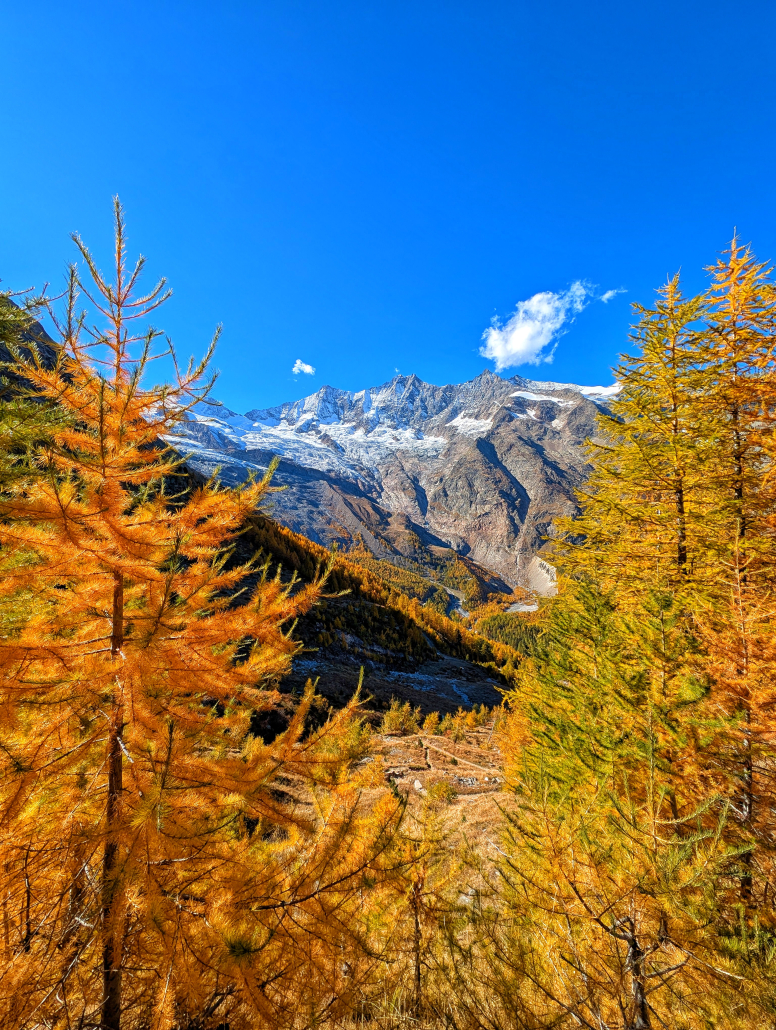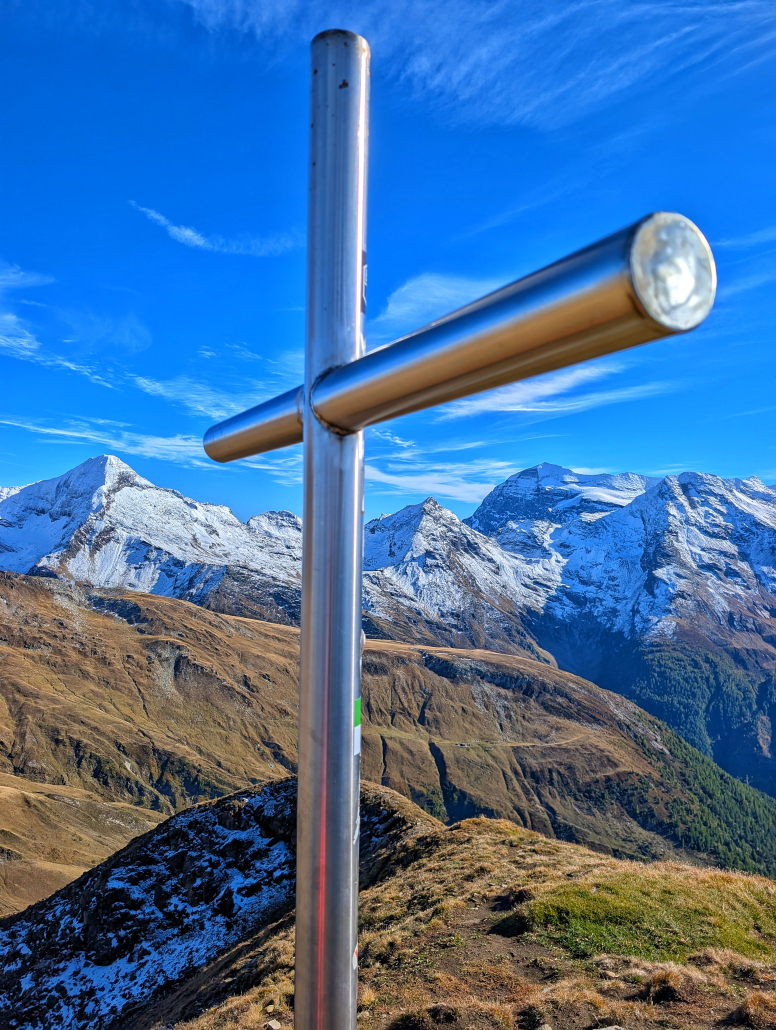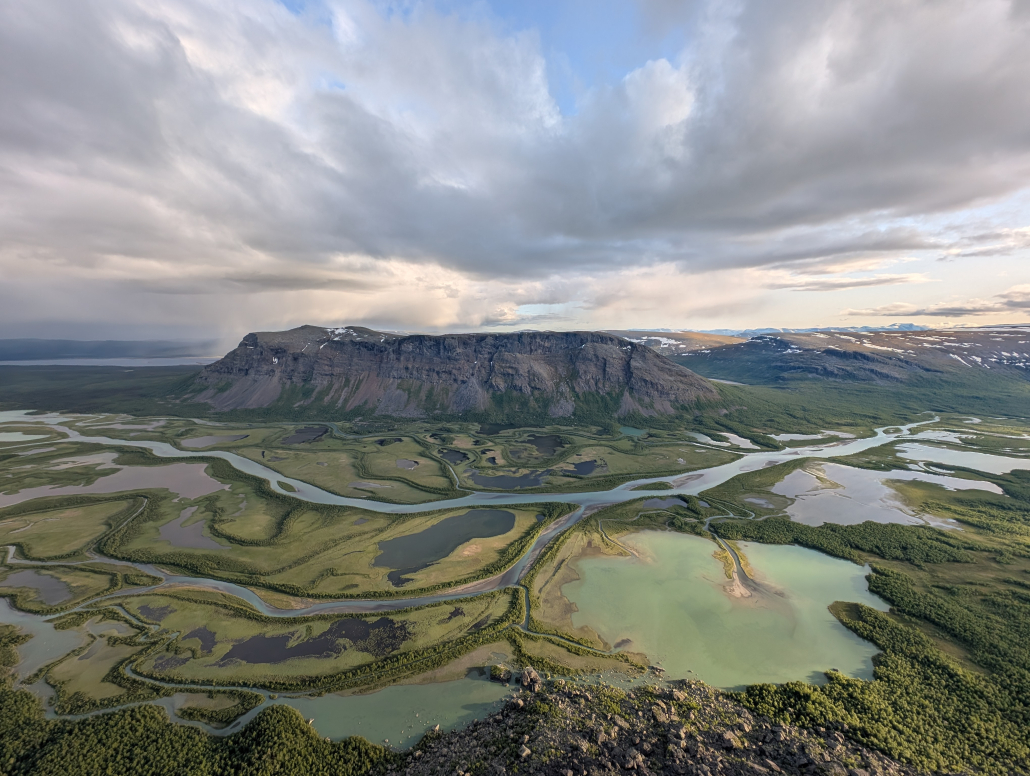Over the last few days, I have trailed two more three-thousand-metre peaks. First up was Piz Sesvenna. A magnificent hike with a dreamlike backdrop. One day later, it was time for the relatively short Piz Umbrail. Here, too, I was rewarded with a fantastic view of the nearby 3,000-metre peaks of South Tyrol and Switzerland.
14.10.2025 – This time, I started early in the morning from Saas-Almagell. Surrounded by the vibrant colors of autumn, I made my way toward the Mittaghorn, which rises 3,143 meters above sea level. The view is phenomenal, as mighty 4,000-meter peaks surround you. The descent led me toward Saas-Fee, where the golden autumn greeted me in all its colorful glory. There are surprisingly many ibex roaming the mountain slopes.

7.10.2025 – I started in the late morning in Grignols, surrounded by quiet alpine meadows. The trail rose steadily, I passed above Saflischpass toward the Fülhorn, revealing wide views over the Simplon area and the distant glacier peaks. From there, I continued to the Folluhorn – a wilder, more rugged summit where silence and wind become your only company.
The ridge walk between the two peaks was pure freedom – raw, open, and deeply Swiss. On the descent to Rosswald, the landscape softened again, passing through golden grass and larch forests.

It was more than a trail – it felt like a journey of discovery. A confession of a Swiss Soul connecting with its mountains, one step at a time.
2.10.2025 – From Champéry to the Haute Cime – My Journey into the seven Dents du Midi
I set out from Champéry early in the morning, the village still quiet, the peaks of the Dents du Midi glowing in the first light. The trail rose quickly through forest and pasture, pulling me higher into the mountains.
By the time I reached the Cabane de Susanfe, I felt the closeness of the mountains all around. I continued for the Haute Cime, the highest of the seven Dents. The climb was steep and rocky, every turn testing my breath and my legs, but also filling me with anticipation. When I finally stood at 3,257 meters, the panorama stopped me in my tracks: an endless sweep of peaks, clouds drifting below, silence broken only by the wind or birds.
On the long way back, tired but content, I carried with me more than just the view. The Haute Cime gave me that rare gift mountains sometimes offer: the reminder of how small we are, and at the same time how limitless we can feel.
This summer, I continued to trail several high Swiss mountains, especially three-thousanders. Each one left its own mark on and for me.
The Punta Terra Rossa/Wasenhorn (3’246m) greeted me with its warm, red stone and the feeling of stepping into another world. The view of Monte Leone and the other three and four-thousanders was breathtaking.
On the Sparrhorn (3’020m), the view over the Aletsch Glacier was fantastic.
The Mattwaldhorn (3’246m) & Simelihorn (3’124m) offered me solitude, a peak where silence stretched further than the horizon.
The Almagellerhorn (3’327 m), standing proudly above the Saas Valley, gave me an incredible feeling, especially during the uphill climb.
The Wildstrubel (3’244m) hike was a chapter of its own. Long and steady, it led me through vast alpine landscapes. It wasn’t just about reaching a peak—it was about moving through a world of glaciers, high plateaus, and silence, a reminder that sometimes the journey itself holds the greatest reward.
Each summit carried its own challenge, but also its own gift. With every climb, I felt myself becoming lighter, freer, and more connected to the mountains. By the end of summer, I realized I wasn’t just collecting peaks—I was collecting moments of clarity, pieces of myself that only the high places could return to me.
Autumn has already arrived, the light softer, the air sharper. The mountains call me still, and I know the season of discovery continues—just in a different color, a different rhythm, but with the same heartbeat.

The tour starts at the Simmenfälle (1,100 m) above Lenk, where the Simme river cascades down in multiple steps. From here, the trail climbs steadily through forest and alpine pastures to the Flueseeli and on toward the Flueseeli plateau (~2,000 m). The landscape quickly changes from green meadows into rock and scree.
Above ~2,500 m, the route crosses more barren alpine terrain before reaching the final push to the Wildstrubel summit plateau (3,243 m), where you are rewarded with sweeping views across the Bernese Alps, Wallis/Valais 4000ers, and down into the Rhône Valley.
The descent follows the same way back down to the Simmenfälle.
Key Facts
Highlights: Simmenfälle waterfalls, Flueseeli, remote high alpine landscapes, panoramic summit
Start/Finish: Lenk, Simmenfälle (1,100 m)
Summit: Wildstrubel (3,243 m)
Elevation gain: ~2,100 m

The second part of the Södra Kungsleden, running from Sälen to Flötningen, covers roughly 145 kilometers and took us seven days to complete, including some detours. Compared to the Storlien–Grövelsjön stretch, this section is wilder, more solitary, and less frequented, which gives it a distinctly remote character. The trail follows the Scandinavian mountain range northwards along the Norwegian border and leads through a varied landscape of open mountain plateaus, birch forests, deep spruce valleys, and countless lakes.
Starting in Sälen, the trail first passes through forest and lake country before reaching Fulufjället National Park, home to Sweden’s highest waterfall, Njupeskär, which plunges 93 meters. On the plateau above, hikers walk across vast, windswept terrain and may visit Old Tjikko, a 9,500-year-old spruce often described as the world’s oldest living tree. From there, the path continues through sparsely populated wilderness, where encounters with moose and rich birdlife are common.
Infrastructure is more limited here than in the northern Kungsleden sections. There are very well-maintained STF huts and basic cabins. Resupply opportunities are rare. Toward Flötningen, the trail gradually descends into dense forests and secluded valleys, eventually reaching the small settlement at the border, which also serves as a gateway toward Grövelsjön, Femundsmarka National Park in Norway.
In essence, the Sälen–Flötningen stretch of the Södra Kungsleden offers a quieter and more rugged experience, rewarding hikers with striking natural contrasts, from the thunder of Njupeskär waterfall to the silence of remote forest wilderness.

Over the last eight days, I have hiked approximately 225 kilometres through the last remaining wilderness in Europe, encompassing and traversing Sarek National Park. As always, it was very impressive and full of experiences. There are places and moments in life for which there are no words. Being in harmony with nature is a profoundly enriching and satisfying experience.

Thank you Lapland!
We spent an inspiring time in beautiful South Tyrol, surrounded by high snow-covered mountains and lots of love. At an altitude of about 1730 meters, we embraced the joy of winter activities. The breathtaking views captured our hearts. I went cross-country skiing for the first time in five new spots, including Val Müstair and Unterengadin (between Scuol and La Martina). The magnificent trails invited us to explore, while Val Venosta became a place to linger and dream.

January 2025 – After the polar night in December, when no sun-ray touches your skin, the days slowly start getting longer, and the increasing amount of light inspires you to hit the slopes. This region is energizing for one who loves cross-country skiing. I was embedded in love. Awe and wonder were my constant companions in all my activities and even caught me in my dreams. Aurora, the northern lights, were dancing and shining. They directly spoke to my heart.

There are eight seasons in Lapland. Each has its own specialty. This was my third time in Finnish Lapland; it feels like home every time. You not only feel nature, but you are entirely immersed in it, woven in it, part of it; you are one; you are nature!
